Zimtsterne (Cinnamon Star Cookies)
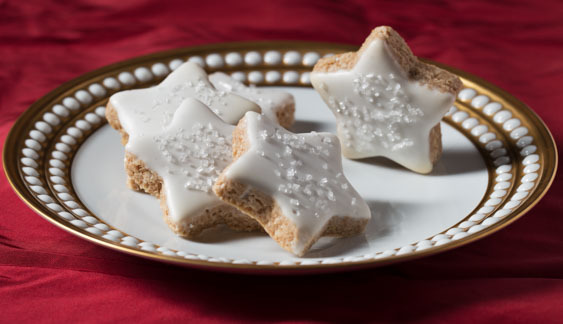
introduction
Zimtsterne are chubby ground-almond meringues that practically vibrate with the warmth of cinnamon. Irresistible! Zimtsterne originated in Schwabia, a curiously contained region of upper Baden, where the reigning accent can be as difficult to understand as, say, a mouthful of Maultaschen—Schawabia’s meat dumplings that enjoy protection as a regional specialty under laws of the European Union. Additional details of Zimtsterne history proved scarce in German and English sources alike, but the cookies are iconic during the Advent Season.
Zimtsterne have rules. Flour is not permitted to exceed 10 percent of the weight of its dry ingredients, and indeed most recipes contain none. The rolled-out dough is flooded with royal icing and cut into stars, then dried overnight at room temperature before it is baked. Not an easy task. (The Germans make a special cutter to accomplish this feat, but we did not have one.) The royal icing is not supposed to brown on the surface, but remain snowy white. The cookies must not be too thin.
We won’t pretend Zimtsterne are the easiest cookies we’ve ever produced, but they are absolutely among the tastiest. We went crazy over them. Their icing is like crisp glass, succumbing to a chewy, nutty meringue cookie. Cinnamon rules supreme, experiencing virtually no competing flavors save a little offset accent of lemon zest. Yet the flavor combination is powerful. Zimtsterne are outstanding with coffee.
Baking Notes
Since we’re talking stars, let’s talk cinnamon. Korintje cinnamon from Indonesia, often known as cassia cinnamon—spicy, woodsy, aromatic—is the product you’ll find in American grocery stores. “True” cinnamon, which comes from Ceylon (Sri Lanka), is milder and sweeter than cassia cinnamon—and more expensive. We made a point of ordering genuine Ceylon cinnamon from the Spice House for Zimtsterne trials. The product was quite noticeably subdued with a slight nutmeg and vanillin component. We longed for the cinnamon of our childhood, however, and cast the real cinnamon aside for a fresh jar of Simply Organic ground (cassia) cinnamon. Germans and other Europeans prefer Ceylon cinnamon, of course. (They would.) In fact, the Bundesinstitut für Arzneimittel und Medizinprodukte, the German FDA, has cautioned against the widespread use of cassia cinnamon owing to its high levels of a cancer-implicated compound called coumarin. If your cinnamon intake is for medicinal purposes, by all means avoid cassia cinnamon. If the cinnamon is simply for stars, use whichever you fancy. Just make sure it is fresh!
German Zimtsterne have a rather coarse, nubby texture. For this, blanched whole almonds—half processed finely, half somewhat coarser—are the best approach, but www.nuts.com makes a nice organic medium-fine almond flour, which completely takes guesswork out of the processing process. Do not use ultrafine almond flour—the cookies will not have the correct texture. Big Tree Organic Farms has fresh blanched whole almonds.
It is important to weigh the egg whites for this recipe.
Don’t roll the dough out too thinly—the cookies’ finished height should be ⅜ inch thick.
Without the special German spring-loaded star cutter that opens and drops the iced stars flawlessly onto the baking sheet, these cookies are tricky. You will need a 2-inch star-shaped biscuit, cookie, or fondant cutter, preferably not too pointy, like this plastic set from Wilton, available at Amazon, or this metal Wilco set, also from Amazon, and some on-fleek wrist action to snap the iced cookies out of the cutter. Carefully pushing the cookies up and out of the cutter with your fingers works, too. But if the prospect or the reality becomes too frustrating, simply cut the iced raw cookies into triangles, set them on the prepared baking sheets, dry, and bake.
If the icing becomes too thick to glide flawlessly over the “cookie carpet,” a drop or two of raw egg white or lemon juice will thin it like magic. As we mentioned above, the icing is meant to stay snowy white, even as the cookies bake. This is why an extra baking sheet on the upper oven rack is essential—it prevents the icing from taking on color.
equipment mise en place
For the cookie dough, you will need a digital kitchen scale, a food processor (if using blanched almonds), a medium bowl, a stand mixer fitted with the whisk attachment, a saucepan onto which the mixer bowl rests snugly, a whisk, an instant-read thermometer, a rubber spatula, parchment paper, a ruler, a rolling pin, four baking sheets, silicone baking mats (optional), a small bowl, an offset metal icing spatula, and a 2-inch star cookie cutter.
For the icing, you will need a digital kitchen scale, a stand mixer fitted with the whisk attachment, a 1- or 2-cup liquid measuring cup, a rubber spatula, and an offset metal icing spatula.
-
for the cookie dough:
-
1pound blanched whole almonds or 1 pound medium-fine almond flour
-
1
-
1tablespoon ground cinnamon
-
1teaspoon finely grated lemon zest
-
¼teaspoon fine sea salt
-
2ounces egg whites
-
3ounces superfine sugar
-
-
for the icing:
-
1ounce egg white
-
2teaspoons juice from 1 lemon
-
5.4ounces confectioners’ sugar, sifted
-
Sparkling sugar, for sprinkling (optional)
-
-
Make the cookie dough: If using blanched whole almonds, turn half of the almonds into a food processor and process to a coarse meal, about 20 seconds (fig. 1.1). Transfer the ground almonds to a medium bowl. Process the remaining almonds to a very fine meal, 30 to 40 seconds. Add this batch to the first batch and stir well. If using almond flour, turn it in a medium bowl. Measure 4 ounces of the ground almonds or of the almond meal into a small bowl and set aside. Stir the cake flour, cinnamon, lemon zest, and salt into the larger quantity of almonds and rub the mixture with your fingertips until well combined.
-
Turn the egg whites and superfine sugar into a clean stand-mixer bowl and set the bowl snugly onto saucepan filled with about 2 inches of water; the water should not touch the bottom of the bowl. Set the saucepan over medium heat and whisk the egg whites and sugar, allowing the water underneath to reach a bare simmer, until the mixture is opaque and frothy (fig. 2.1) and registers 130 degrees on a clean instant-read thermometer. Attach the bowl to the stand mixer fitted with the whisk attachment and beat on medium-high speed until the egg whites are thick and glossy, with slightly drooping tips (fig. 2.2), about 5 minutes. Remove the bowl from the mixer and knock the meringue off the whisk attachment back into the egg white mass. Add the almond meal mixture and fold with a rubber spatula (fig. 2.3) until a fairly firm and only slightly sticky dough forms. Turn the dough onto a sheet of parchment paper and place another sheet of parchment on the top. Press the dough into a rectangle with your hands, and then roll it out into a rectangle measuring about 12 by 8½ inches by ⅜ inch thick (fig. 2.4). Slide the dough, sandwiched between the parchment sheets, onto a baking sheet and refrigerate for at least 3 hours or up to overnight.
-
Make the icing: Combine the egg white, lemon juice, and confectioners’ sugar in the bowl of a stand mixer fitted with the whisk attachment. Beat on medium-high speed until the icing is opaque and glossy but fluid enough to flow, about 3 minutes. Pour the icing into a 1- or 2-cup liquid measuring cup, scraping the mixer bowl with a rubber spatula.
-
Line 2 baking sheets with silicone baking mats or parchment paper. Fill a small bowl with water. Remove the dough from the refrigerator, lift off the top sheet of parchment, flip the parchment with dough on it, and then lift off the parchment. Pour about two-thirds of the icing onto the center of dough rectangle and use an offset icing spatula to “flood” it smoothly and evenly over the surface, spreading it all the way to the edges (fig. 4.1). Dip a 2-inch star cookie cutter in the bowl of water, shake off the excess, and cut out stars one at a time, pushing the cutter through the icing and dough (fig. 4.2). Lift the cutter; the cookie will remain inside it. Holding the cutter tightly, shake the cookie out onto the palm of your hand (fig. 4.3) with a quick downward thrust of the wrist. If the cookie does not shake free, very carefully use your fingers to push the dough up and out of the top of the cutter. Slip the cookie onto one of the prepared baking sheets and sprinkle with sparkling sugar (fig. 4.4) if desired. Continue to cut out stars, washing and dampening the cutter it after each cookie; space the cookies about ½ inch apart on the baking sheet. When you have nothing but scraps of dough (fig. 4.5), use the spatula to “plane off” as much of the icing as possible from the scraps and return the icing to the measuring cup. Sprinkle a handful of the reserved ground almonds or almond flour onto the scraps, gather them up, and knead (fig. 4.6) until they match the consistency of the original dough, adding more almond flour as necessary. Roll the dough out to a thickness of ⅜ inch, flood with icing, and continue to cut out stars. Repeat a third and final time. You should have about 24 cookies. Let the cookies dry, uncovered, at room temperature overnight.
-
Adjust the oven racks to the upper-middle and lower-middle positions. Place a baking sheet on the upper rack (it will prevent the cookies from browning) and heat the oven to 300 degrees. Bake the cookies one baking sheet at a time until the bottoms are tawny and tips have begun to color but the icing is still white, 12 to 14 minutes. You can leave the cookies in the oven longer, so long as the icing remains white. Pay close attention! It is important not to overbake or underbake. Let the cookies cool on the baking sheet. Store the cookies in an airtight container between sheets of waxed or parchment paper; they will keep for a couple of weeks.
-
-
1.1

-
-
-
2.1

-
2.2

-
2.3

-
2.4

-
-
-
4.1

-
4.2

-
4.3
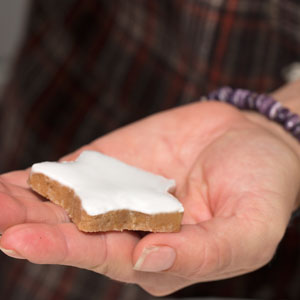
-
4.4
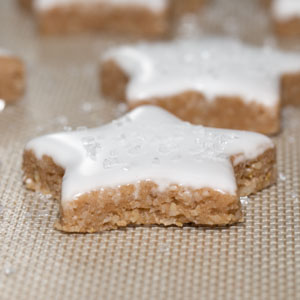
-
4.5
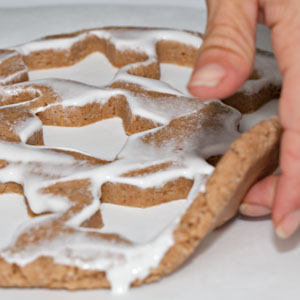
-
4.6
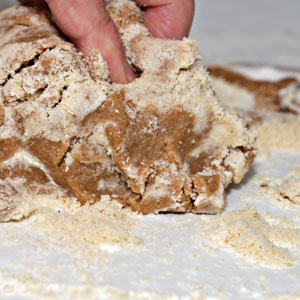
-